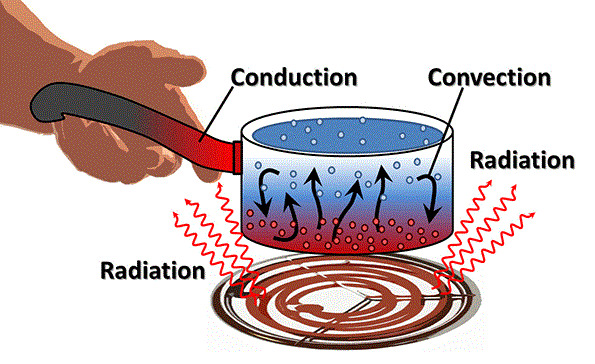In our latest series of articles we have been looking at ideal temperatures in an effort to understand what the perfect climate might be. It is worth though taking a step back to understand the science of how our body cools itself so we understand why certain climates might be less ideal.
In order to survive hot weather, our bodies use 3 methods to shed heat. These are illustrated using the picture below.

Convection (sweating in humans)
Your body sweats as a method of cooling itself. Water in our blood plasma makes its way to the sweat glands and is secreted up through ducts to the skin. On the surface of the skin, the sweat is heated by the body. Heated water molecules move upward in a sweat droplet in a process called heat convection. Those with sufficient energy will break the surface tension of the sweat droplet and escape as evaporated water vapor. The higher the humidity of the air is the more difficult it will be for this process to occur.
Conduction (heat transfer from contact with cooler things)
Another way that our body is cooled is by Heat Conduction. This is where a hot object and a cold object transfer heat in an effort to reach Thermal equilibrium. Taking a swim, drinking cold water, or laying on a cold floor are all ways your body can lose heat through Conduction.
Our bodies also dissipate heat in the surrounding air through conduction. The more water vapor in the air and the cooler the air the easier this takes place. If the air is cooler than our body, heat will be transferred to the air mass. If the air is hot and humid for example 26°C at 80% relative humidity it will feel uncomfortable even if the air is well below our body temperature. Conduction is still taking place but our bodies
Radiation (release of electromagnetic energy)
The final way your body loses heat is through Thermal Radiation. Thermal radiation is electromagnetic radiation generated by the thermal motion of particles in matter. All matter that is not at absolute zero generates some type of Thermal radiation. At the same time that your body is releasing Thermal Radiation it can also be absorbing it from other objects like the sun, a heater or even warm air molecules.
Why does a fresh breeze or a fan make us feel cooler?
Surrounding our bodies is a thin warm layer of air close to the skin. As moving air hits our body it dissipates this warm air which aids in cooling and accelerates the convection process described above. Moving air that is cooler than the body also conducts heat away from the body through surface contact.
What temperature is too hot?
The wet-bulb temperature of 35°C is the maximum temperature the body can handle. Already at the wet-bulb temperature of 30°C the body can have serious problems cooling itself because evaporation which is the body’s primary cooling system does not function in saturated air.
The best way to cool the body at these temperatures is to take a swim in cool water. Through conduction with the water, the body can lose its excess heat quickly. Air conditioning is another good option because it removes both moisture and heat from the air.